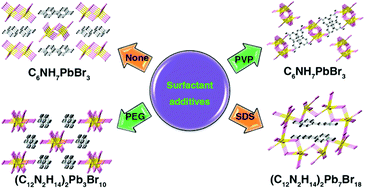Surfactants as additives make the structures of organic–inorganic hybrid bromoplumbates diverse†
Abstract
Although surfactant-facilitated crystallization has been widely used in pharmaceuticals, metal–organic frameworks (MOFs), chalcogenides and colloidal nanocrystals, using surfactants as additives to control the crystal growth of metal halides in the macroscale is unexplored. In this contribution, we used N-methylate 4,4′-bipyridine bromoplumbates as a model system to prove that surfactants as additives could make the structures of organic–inorganic hybrid bromoplumbates diverse. By only changing different surfactants, four new hybrid bromoplumbates including the first novel 3D open framework hybrid bromoplumbate [(C12N2H14)2Pb7Br18] (except perovskites) and a pair of 1D polymorphs were obtained. The related physical properties including optical band gaps, FT-IR and TGA-DSC for the as-obtained compounds have been carefully investigated. In addition, an interesting mother-liquor-facilitated single-crystal-to-single-crystal (SCSC) phase transition is also revealed. Our strategy to employ surfactants to control the crystal growth of metal halides could offer exciting opportunities for discovering novel organic–inorganic hybrid crystals with diverse structures and distinctive properties.

- This article is part of the themed collection: In honour of Mercouri G. Kanatzidis for his contributions to Inorganic Chemistry for over 30 years

 Please wait while we load your content...
Please wait while we load your content...